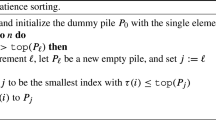Abstract
Tradeoffs between time complexities and solution optimalities are important when selecting algorithms for an NP-hard problem in different applications. Also, the distinction between theoretical upper bound and actual solution optimality for realistic instances of an NP-hard problem is a factor in selecting algorithms in practice. We consider the problem of partitioning a sequence of n distinct numbers into minimum number of monotone (increasing or decreasing) subsequences. This problem is NP-hard and the number of monotone subsequences can reach \( {\left\lfloor {{\sqrt {2n + \frac{1} {4}} } - \frac{1} {2}} \right\rfloor } \) in the worst case. We introduce a new algorithm, the modified version of the Yehuda-Fogel algorithm, that computes a solution of no more than \( {\left\lfloor {{\sqrt {2n + \frac{1} {4}} } - \frac{1} {2}} \right\rfloor } \) monotone subsequences in O(n 1.5) time. Then we perform a comparative experimental study on three algorithms, a known approximation algorithm of approximation ratio 1.71 and time complexity O(n 3), a known greedy algorithm of time complexity O(n 1.5 log n), and our new modified Yehuda-Fogel algorithm. Our results show that the solutions computed by the greedy algorithm and the modified Yehuda-Fogel algorithm are close to that computed by the approximation algorithm even though the theoretical worst-case error bounds of these two algorithms are not proved to be within a constant time of the optimal solution. Our study indicates that for practical use the greedy algorithm and the modified Yehuda-Fogel algorithm can be good choices if the running time is a major concern.
Similar content being viewed by others
References
Erdös P, Szekeres G. A combinatorial problem in geometry. Compositio Mathematica, 1935, 2: 463–470.
Yehuda R B, Fogel S. Partitioning a sequence into few monotone subsequences. Acta Informatica, 1998, 35(5): 421–440.
Fomin F V, Kratsch D, Novelli J. Approximating minimum cocolorings. Information Processing Letters, 2002, 84(5): 285–290.
Brandstädt A, Kratsch D. On partitions of permutations into increasing and decreasing subsequences. Elektron. Inf. Verarb. Kybern., 1986, 22: 263–273.
Wagner K. Monotonic coverings of finite sets. Elektron. Inf. Verarb. Kybern., Dec. 1984, 20(12): 633–639.
Erdös P, Gimbel J, Kratsch D. Some extremal results in cochromatic and dichromatic theory. Journal of Graph Theory, 1991, 15: 579–585.
Myers J S. The minimum number of monotone subsequences. Electronic Journal of Combinatorics, 2002, 9(2): R4.
Tracy C A, Widom H. On the distributions of the lengths of the longest monotone subsequences in random words. Probab. Theory Relat. Fields, 2001, 119: 350–380.
Siders R. Monotone subsequences in any dimension. Journal of Combinatorial Theory, Series A, 1999, 85(2): 243–253.
Matoušek J, Welzl E. Good splitters for counting points in triangles. In Proc. The 5th Ann. ACM Conf. Computational Geometry, 1989, pp.124–130.
Fredman M L. On computing the length of longest increasing subsequences. Discrete Mathematics, 1975, 11: 29–35.
Dilworth R P. A decomposition theorem for partially ordered sets. Annals of Mathematics, 1950, 51(1): 161–166.
Frank A. On chain and antichain families of a partially ordered set. Journal of Combinatorial Theory, Series B, 1980, 29: 176–184.
Hoffman A J, Schwartz D E. On partitions of a partially ordered set. Journal of Combinatorial Theory, Series B, 1977, 23: 3–13.
Greene C, Kleitman D J. The structure of sperner k-families. Journal of Combinatorial Theory, Series A, 1976, 20: 41–68.
Greene C. Some partitions associated with a partially ordered set. Journal of Combinatorial Theory, Series A, 1976, 20: 69–79.
Greene C, Kleitman D J. Strong versions of sperner’s theorem. Journal of Combinatorial Theory, Series A, 1976, 20: 80–88.
Author information
Authors and Affiliations
Corresponding author
Rights and permissions
About this article
Cite this article
Yang, B., Chen, J., Lu, EY. et al. Design and Performance Evaluation of Sequence Partition Algorithms. J. Comput. Sci. Technol. 23, 711–718 (2008). https://doi.org/10.1007/s11390-008-9183-2
Revised:
Published:
Issue Date:
DOI: https://doi.org/10.1007/s11390-008-9183-2



